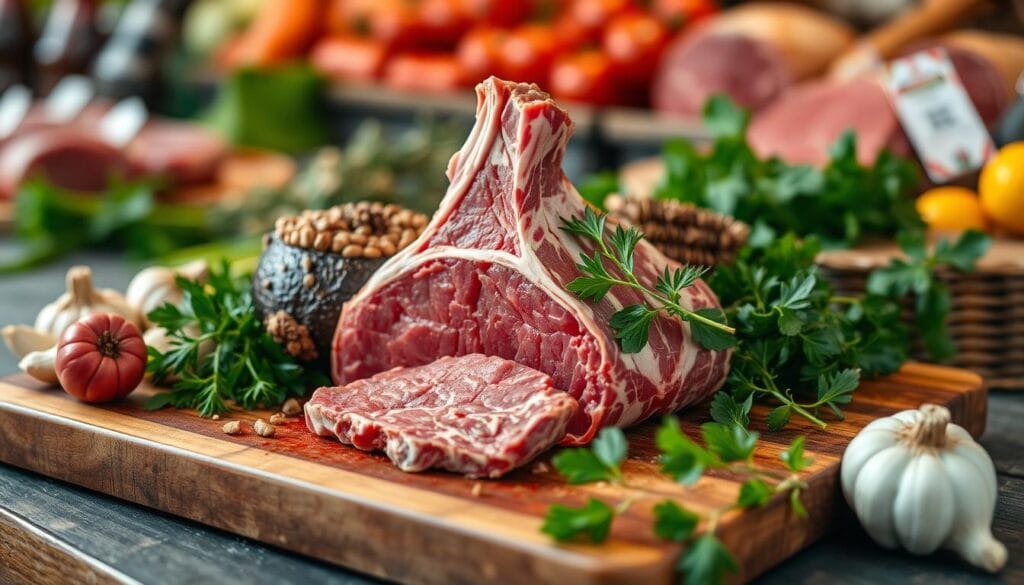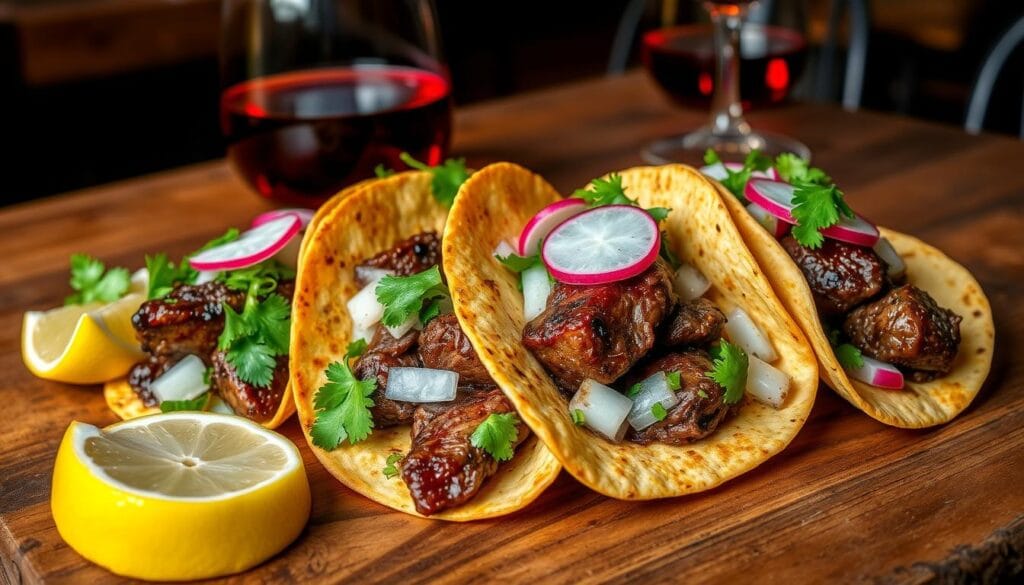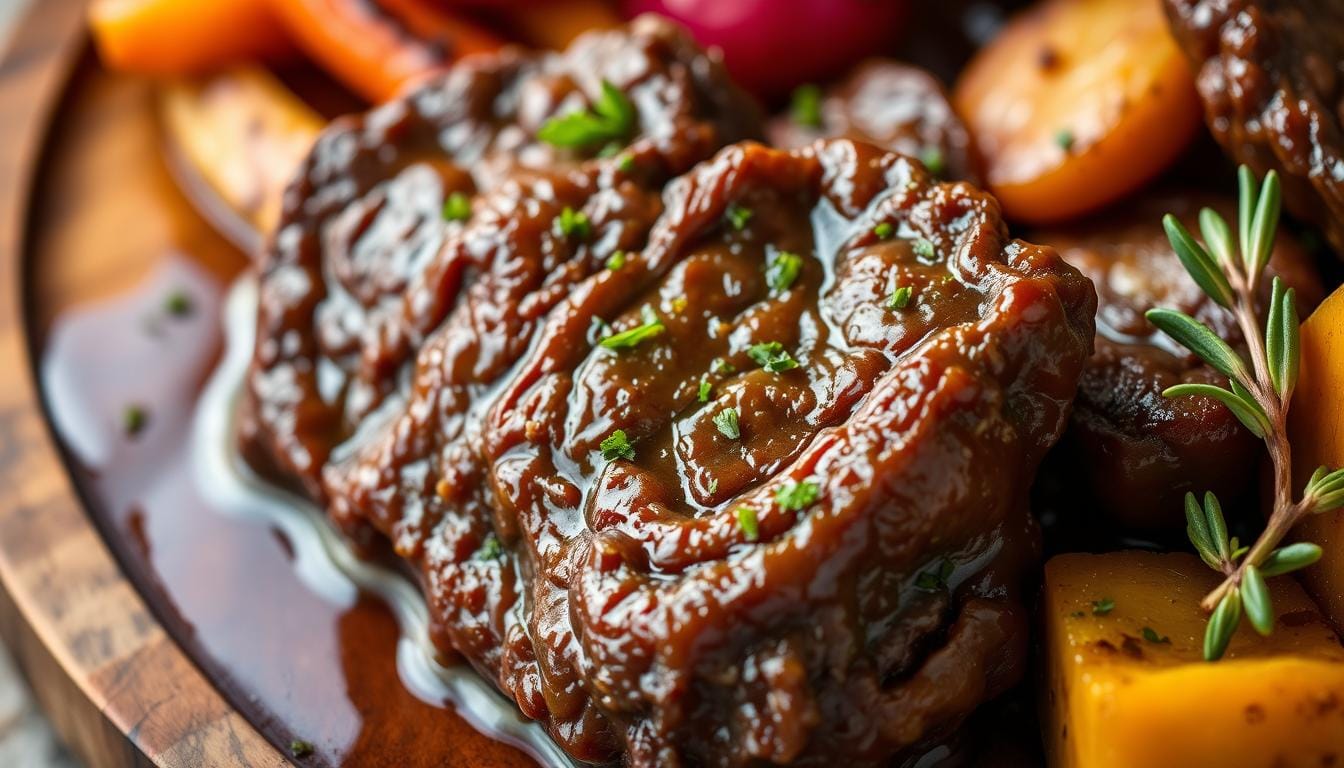Unlock the Secrets of Beef Cheek Meat: Tender and perfect 25
Exploring beef cheek meat reveals a cut packed with iron, protein, and amino acids. It’s a great choice for cooking. Beef cheek comes from a cow’s cheek muscles, known for its rich flavor and tenderness. It’s perfect for slow-cooked dishes, pairing well with Bordeaux red wine and fresh herbs.
Beef cheeks are a budget-friendly option, making them a smart choice for gourmet dishes. You can find quality beef cheek in butcher shops and online. It costs about $14 per lb, making it affordable for many.
Table of Contents
Understanding Beef Cheek Meat: A Premium Cut
Beef cheek meat is a top-notch cut known for its flavor, texture, and health benefits. When cooked right, it turns into a tender delight. It’s a favorite for slow-cooked dishes like beef cheek recipes and beef cheek slow cooker recipes.
Its high collagen content makes it perfect for slow cooking. This breaks down the meat, making it tender. Its rich flavor and tender texture make it ideal for many dishes, from stews to braises.
What Are Beef Cheeks?
Beef cheeks come from the cow’s cheek muscles. They are a premium cut because of their unique qualities. Their high collagen content makes them tender and flavorful.
Why This Cut Is Special
Beef cheek meat is also packed with protein, iron, and amino acids. It’s a nutritious choice for any meal. Its rich flavor and tender texture are perfect for slow-cooked dishes, like beef cheek slow cooker recipes.
Nutritional Profile
Beef cheek meat is a great source of high-quality protein. It’s good for muscle repair and growth. The collagen in it supports healthy skin and joints.
It also has iron, zinc, and B vitamins. These nutrients boost energy and overall health.
The Rich History of Cooking with Beef Cheeks
Cooking with beef cheeks is more than just a skill. It’s a journey through history and culture. Beef cheeks have been a prized dish for centuries, loved by many cultures. From Mexico to Asia, they’ve been used in countless ways, showing their versatility and taste.
In Mexico, beef cheeks are a key ingredient in barbacoa. This dish is slow-cooked in pits or ovens. It makes the meat tender and flavorful, perfect for celebrations. To cook beef cheeks, try braising or slow-cooking them.
Here are some ways to cook beef cheeks:
- Braising: Cook the cheeks in liquid over low heat for a long time. This makes them tender and full of flavor.
- Slow-cooking: Use a slow cooker or oven to cook the cheeks. This method makes them tender and flavorful.
Learning about beef cheeks’ history and cultural importance adds depth to cooking. Whether you’re new to cooking beef cheeks or looking for new recipes, their rich history is worth exploring.
Selecting Quality Beef Cheek Meat
Choosing the right beef cheek meat is key for delicious dishes. You want to make tasty beef cheek tacos or a rich stewed beef cheek meal. So, picking the best meat is crucial.
Start by looking for signs of quality. Fresh, vibrant red color and a firm texture are good signs. The first source says to pick cheeks that are fresh, red, and have no extra fat or sinew. You can find beef cheeks at specialty butcher shops, farmers’ markets, or online.
Visual Indicators of Quality
When picking beef cheek meat, consider these factors:
- Fresh, vibrant red color
- Firm texture
- No excess fat and sinew
The cost of beef cheek meat varies based on quality and source. But, it’s often a budget-friendly choice. Its rich flavor and tender texture make it great for slow-cooked dishes.
Where to Buy Beef Cheeks
You can buy beef cheeks at many places. Look for specialty butcher shops, farmers’ markets, and online. Wagyu beef cheeks are a popular choice for their high quality and flavor.
Essential Preparation Techniques
When you decide to buy beef cheek, it’s crucial to prepare it correctly. This brings out its unique characteristics and flavors. First, trim any excess fat and sinew from the beef cheeks. Then, season them with salt, pepper, and your favorite spices.
This step is essential to enhance the flavor and texture of the beef cheeks. To further elevate the flavor, marinate the beef cheeks in a mixture of olive oil, garlic, and herbs. This will not only add flavor but also tenderize the meat.
Beef cheek meat is perfect for slow-cooked and braised dishes. Some popular seasonings for beef cheeks include Diamond Crystal kosher salt, black pepper, onion powder, garlic powder, smoked paprika, and ground cumin.
Here’s a simple seasoning blend you can try:
- 2 teaspoons of Diamond Crystal kosher salt
- ½ teaspoon of black pepper
- 1 teaspoon of onion powder
- 1 teaspoon of garlic powder
- 1 teaspoon of smoked paprika
- ½ teaspoon of ground cumin
Remember to adjust the amount of seasonings according to your taste preferences. By following these essential preparation techniques, you’ll be able to unlock the full potential of your beef cheeks. This will help you create delicious, mouth-watering dishes.

Whether you’re a seasoned chef or a home cook, learning how to prepare beef cheeks is a valuable skill. It will elevate your cooking to the next level. So, go ahead and buy beef cheek, and start experimenting with different recipes and seasonings. Find your favorite way to cook this versatile and flavorful cut of meat.
| Ingredient | Quantity |
|---|---|
| Beef cheeks | 4 pounds (6-8 cheeks) |
| Diamond Crystal kosher salt | 2 teaspoons |
| Black pepper | ½ teaspoon |
| Onion powder | 1 teaspoon |
| Garlic powder | 1 teaspoon |
| Smoked paprika | 1 teaspoon |
| Ground cumin | ½ teaspoon |
Mastering Slow-Cooking Methods for Beef Cheeks
Slow-cooking beef cheek meat is the best way to make it tender and flavorful. You can use a Dutch oven, slow cooker, or pressure cooker. Cooking it low and slow is key to getting great results.
First, season the beef cheek meat with your favorite spices and herbs. Then, pick your slow-cooking method. Braising, slow roasting, and sous vide are popular choices. Marinating is optional but can add extra flavor, especially with acidic ingredients like wine or citrus.
Braising Basics
Braising is a top choice for cooking beef cheeks. It involves cooking the meat in liquid over low heat for a long time. This method tenderizes the meat and creates a rich sauce. You can use a Dutch oven or slow cooker with ingredients like red wine, beef broth, and soy sauce.
Slow Cooker Techniques
Slow cookers are also great for cooking beef cheeks. Season the meat, add your favorite ingredients, and cook on low for 6-8 hours. This is perfect for busy days, as it cooks while you’re away.
Pressure Cooker Options
Pressure cookers are ideal for quick and efficient cooking. They’re great for those in a hurry, as they can cook the meat in just a few hours. Season the meat, add your ingredients, and follow the manufacturer’s instructions.
Garlic, onions, thyme, and bay leaves are popular ingredients for beef cheeks. You can also add carrots, celery, and potatoes for extra flavor and texture. These methods allow you to make a variety of dishes, from tacos and burritos to stews and soups.
| Cooking Method | Cooking Time | Temperature |
|---|---|---|
| Braising | 3-4 hours | 150°C (300°F) |
| Slow Cooker | 6-8 hours | Low |
| Pressure Cooker | 1-2 hours | High |
Creative Beef Cheek Recipes and Applications
Beef cheek recipes offer endless possibilities. You can make everything from classic braised beef cheeks to Mexican-style tacos and Asian dishes. Cooking beef cheeks in a slow cooker is a favorite method. It makes the meat tender and flavorful.
Some popular beef cheek recipes include:
- Classic Braised Beef Cheeks: This recipe involves searing the beef cheeks and then slow-cooking them in a flavorful liquid, such as red wine and beef broth, until they are tender and falling apart.
- Mexican-Style Beef Cheek Tacos: This recipe involves cooking the beef cheeks in a spicy tomato-based sauce and serving them in tacos with your favorite toppings.
- Asian-Inspired Preparations: This recipe involves cooking the beef cheeks in a sweet and sour sauce, such as a mixture of soy sauce, honey, and rice vinegar, and serving them with steamed vegetables and rice.
No matter which recipe you choose, beef cheek meat is sure to impress. Its rich flavor and tender texture make it a standout. So why not get creative and try out some new beef cheek recipes today?
| Recipe | Cooking Time | Servings |
|---|---|---|
| Classic Braised Beef Cheeks | 4-6 hours | 5 |
| Mexican-Style Beef Cheek Tacos | 2-3 hours | 4 |
| Asian-Inspired Preparations | 1-2 hours | 3 |
Common Mistakes to Avoid When Cooking Beef Cheeks
Learning to cook beef cheeks can be tricky. One big mistake is cooking them too fast or at too high a heat. To fix this, cook them low and slow. This method breaks down the tough parts, making the meat tender and juicy.
Here are some tips to keep in mind:
- Cooking temperature: Keep it low, around 325°F (163°C), to avoid toughness.
- Cooking time: Let the beef cheeks cook for 6-8 hours to get them tender.
- Moisture: Use a braising liquid or sauce to keep the meat moist.
By following these tips, you can make delicious beef cheek dishes. Use top-quality ingredients like Wagyu beef cheeks. Cook with patience and care. With time, you’ll get better at cooking beef cheeks and enjoy their rich flavor and tender texture.
Remember, the secret to great beef cheek cooking is to cook it low and slow. This method makes the meat tender and juicy. Beef cheek is perfect for slow-cooked dishes, making it great for special occasions or everyday meals.
| Cooking Method | Cooking Time | Cooking Temperature |
|---|---|---|
| Braising | 6-8 hours | 325°F (163°C) |
| Slow Cooking | 8-10 hours | 275°F (135°C) |
Wine Pairing and Serving Suggestions
Choosing the right wine for beef cheek dishes is key. For beef cheek tacos, a medium to full-bodied red wine works well. Minervois or Syrah are great choices. Their firm tannins and balanced acidity cut through the dish’s richness.
For stewed beef cheek, a lighter, rustic red wine is better. Big tannins can be too much. Opt for wines with smoother tannins like Grenache, Malbec, or Tempranillo.
Best Wine Matches
- Minervois: pairs well with hearty and meaty dishes like beef cheek stew
- Syrah: complements the rich flavor of beef cheek tacos
- Grenache: a good match for stewed beef cheek with its smooth tannins
Complementary Side Dishes
Choose side dishes that enhance the beef’s rich flavor. Roasted vegetables, mashed potatoes, or a simple green salad are great. For beef cheek tacos, add traditional Mexican sides like salsa, avocado, and sour cream.

| Wine | Pairing Suggestions |
|---|---|
| Minervois | beef cheek stew, venison, lamb tagine |
| Syrah | beef cheek tacos, grilled meats, game |
| Grenache | stewed beef cheek, roasted vegetables, mashed potatoes |
Conclusion: Embracing the Versatility of Beef Cheeks
Beef cheek meat is a versatile ingredient that should be in your kitchen. It has a tender texture and a deep flavor. This cut can make your dishes stand out.
Whether you’re an experienced cook or new to premium meats, buying beef cheek is a great choice. It offers endless possibilities for your cooking.
Beef cheeks can be used in many dishes, from slow-cooked braises to tacos and Asian dishes. By exploring different cooking methods, you can create amazing meals. So, try beef cheeks and impress your guests and taste buds.
FAQ
What are beef cheeks?
Why is beef cheek meat special?
What are the best methods for cooking beef cheeks?
Where can I buy beef cheeks?
What are some common mistakes to avoid when cooking beef cheeks?
What wine pairs well with beef cheek dishes?
Tell us your comment .
There are no reviews yet. Be the first one to write one.

